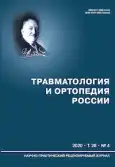Vol 26, No 4 (2020)
- Year: 2020
- Published: 16.12.2020
- Articles: 19
- URL: https://journal.rniito.org/jour/issue/view/48
- DOI: https://doi.org/10.21823/2311-2905-2020-26-4
Full Issue
Editorials
 7
7


СLINICAL STUDIES
Diagnosis of Late Periprosthetic Joint Infection. Which Diagnostic Algorithm to Choose?
Abstract
 9-20
9-20


Periprosthetic Joint Infection after Primary Total Knee Arthroplasty With and Without Sinus Tract: Treatment Outcomes
Abstract
 21-31
21-31


Alternative Techniques of Ligament Reconstruction in Patients with Combined Cruciate and Postero-lateral Corner Injuries of the Knee
Abstract
 32-44
32-44


Extirpation of the Thoracic and Lumbar Hemivertebrae from the Dorsal Access Using the Ultrasonic Bone Scalpel in Children: The Result of a Prospective Multicenter Study
Abstract
 45-55
45-55


Compare of Anterior Approaches in Acetabular Fractures Treated by the Standard Ilioinguinal Versus the Stoppa/Iliac Approaches
Abstract
 56-67
56-67


Surgical Treatment of Humerus Fracture-Dislocations: Medium-Term Results
Abstract
 68-79
68-79


Theoretical and experimental studies
Gender Differences of the ACL Insertion Sites
Abstract
 80-92
80-92


Morphological Changes in the Tibial Nerve During the Treatment of Large Tibia Defects Using Ilizarov Apparatus Combining with the Masquelet Technique: Experimental Study
Abstract
 93-101
93-101


Case Reports
Translocation of Clostridial Infection as a Complication of Hip Arthroplasty in the Early Postoperative Period: Case Report
Abstract
 121-129
121-129


Metallic Mercury in the Soft Tissues of the Hand: Case Report
Abstract
 130-137
130-137


Trauma and orthopedic care
The Algorithm for Territorial Distribution of Public Emergency Rooms in Megapolis (by the Example of Moscow)
Abstract
Background. The lack of a system for evaluating the feasibility of new trauma and orthopedic departments in outpatient clinics under construction creating is one of the main reasons for the imbalance in their territorial location. Therefore, one of the most urgent modern tasks in the megalopolis healthcare organization — is to develop a system for effective regulation of the trauma and orthopedic outpatient departments network construction. The purpose of the study is to improve the effectiveness of outpatient trauma and orthopedic care for megalopolis residents. Materials and Methods. In the research process, theoretical (formalization, synthesis, deduction) and empirical (observation, comparison, modeling, measurement) methods were used. A total of 67 emergency trauma outpatient departments in Moscow were sampled and data on their attendance for April 2019 were collected. Results. Creation of a mathematical model of the network of outpatient primary trauma care and a basic algorithm for estimating the average time from the moment a patient received injuries to the time of primary care in one of the emergency outpatient trauma units of the medical organizations of the capital, which can be used by the executive bodies of the healthcare organization cities in solving administrative and economic problems. Conclusion. The developed specialized mathematical algorithm for assessing the existing effectiveness of the already existing emergency outpatient trauma units network and the distribution of new units allows you to create an “ideal” model for the location of these deparments in a megapolis. In the future, this model can be developed taking into account the development of the transport network, the financing of emergency rooms, etc.
 138-149
138-149


Reviews
Arthroscopy for Knee Osteoarthritis in the XXI Century: a Systematic Review of Current High Quality Researches and Guidelines of Professional Societies
Abstract
 150-162
150-162


Management of Chronic Pain Syndrome in Knee Osteoarthritis with Selective Embolization of Popliteal Artery Branches: Review
Abstract
 163-174
163-174


METHODS OF EXAMINATIONS
Magnetic Resonance Imaging Identification of Rotator Cuff Pathology: Inter-rater Realibilty
Abstract
 102-111
102-111


Microscopic Examination of Foot Joints Components in Charcot Arthropathy Complicated by Osteomyelitis
Abstract
 112-120
112-120


Comments
 175-177
175-177


Anniversaries
 178
178


Obituaries
 179
179












